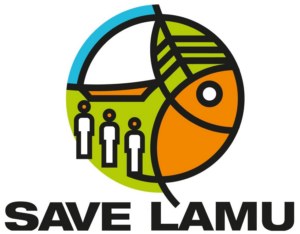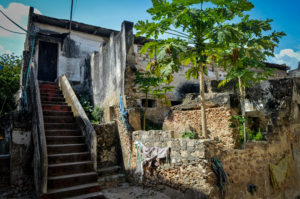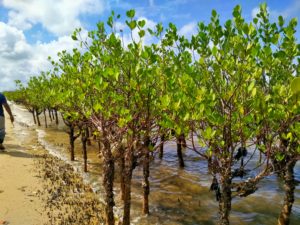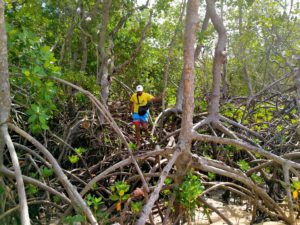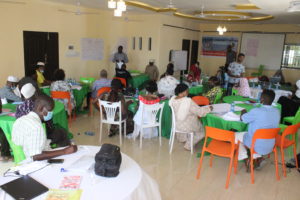It was recognized as a world Heritage site by UNESCO since 2001, it is one of the oldest towns in East Africa, It is a place where culture is preserved since before independence, with some buildings as old as 700 years since its construction, it has been a tourist destination for decades with visitors coming in from all corners of the world, This is Lamu a historical site on the Kenyan coastal strip bordering Somalia on the North, down to the Tana Delta on the South.
One of Lamu’s old Mosque in Lamu (Msikiti wa Pwani)
For the longest time the Lamu community has preserved its culture from traditional ways of doing things, from the dressing code, use of mangroves used to constructing the Swahili houses, Wall decorations, and the use of donkeys as a main source of transportation within the Amu Island.There are different types of mangroves in Lamu which includes;
Mangroves in Lamu Photo|Khadija Juma
- Mlilana
- Mutu
- Ntu
- Mkoko
- Mkandaa
- Mwia
- Mkomafi
- Kikandaa
Many of our indigenous identities were distracted including cutting down of 30,000 acres of mangroves to pave way for the construction of the Lamu port, and the dredging of the sea along the Lamu port, an area which was known for fishing tons of fish for consumption and business purposes to transport to other parts of the Country and sometimes outside Country.
LAPSSET Community Forum in Lamu
Save Lamu brought together representatives from different parts of the Country whose areas are linked with the LAPSSET project, which included Turkana, Isiolo, Marsabit, Samburu, Pokot, Lamu and neighboring County Tana River, through this platform members present gave their views and the kind of challenges they are facing in their respective home areas.
Background check
It is 3 years and counting since the judgment in the petition number 22 of 2012 was issued by the High Court at Nairobi. This was a landmark judgment which recognized the right of traditional fishermen to their fishing sites and awarded the fishermen shillings 1.76 billion as compensation for the losses incurred. The case was brought by residents of Lamu County on 25th January 2012
After the Lamu Community got wind of the lapsset project and were aggrieved by the manner in which the Lamu Port South Sudan Ethiopia Transport Corridor (LAPSSET) was designed and implemented without public participation and environmental and social impact assessment.The project was commenced without a Strategic Environmental Assessment (SEA) and the ESIA should have had an Environmental Management Plan but it did not have this contrary to the Environmental (Impact Assessment and Audit) Regulations of 2003.
Poorly done impact assessment
The ESIA license was exclusively for the first three berths yet the LAPSSET involves other components that were not captured in the project assessment. This coupled with an inadequate SEA that failed to consider program alternatives threats to marine life, water, and air, rendered the project irreparably flawed. The court found that the respondents failed to adhere to the EIA conditions in 2.3, 2.23 which stated that the project proponent will provide modern fishing gear and fish landing sites with cold rooms as well as ensure strict adherence to the Environmental Monitoring and Management Plan (EMMP) respectively. Violation of public participation requirements Even if the LAPSSET project is an initiative of the National Government, the County government through the principle of subsidiarity is entitled to be consulted because it has the best knowledge of the effects and concerns of its community and region in which the project will be implemented. They weren’t consulted adequately.
The court found that the project proponents violated the requirements of public participation. The project proponents are obligated under the constitution and EMCA to give the public a chance to participate both in the design and implementation of the project and its components. The court also found that whereas the project proponents disclosed the ESIA report with the petitioners, they did not give any information about the design or preliminary studies of the project.
The court further found that the only information the petitioners had access to were newspaper articles, advertisements, and verbal presentations at a meeting. Inadequate mitigation measures The court found that the mitigation measures put in place by the proponents were not adequate and were inconsistent with the principle of sustainable development. For this reason, the court determined a violation of the right to a clean and healthy environment.
The court also found the traditional fishing rights of the communities can only be interfered with for a justifiable reason such as conservation of natural resources or, as was in this case, development of a project of national interest. Even in such a case, the government can only interfere with the traditional fishing rights subject to full and prompt compensation. It still incurs a further obligation to give the local fishermen priority to fish for food and commercial purposes over other users as part of their rights as indigenous communities.
The court further found that respondents violated the law when they failed to compensate the fishermen even after identifying them. Indeed, the court found that the indigenous communities of Lamu Island should have been consulted about the cultural effects of the project before the project was started. The court determined that the government violated the cultural rights of the local community by failing to make an environmental monitoring and management plan even after several requests by UNESCO by failing to create an actionable plan to protect the cultural identity of the region, the proponents violated the community’s cultural rights.
Find link for the LAPSSET Community Forum report
https://docs.google.com/document/d/14qYVsfnf5_L18c0MYllahFr5uQqCRXp_v676vM1zFnU/edit?usp=sharing
Story: Save Lamu| Khadija Juma
